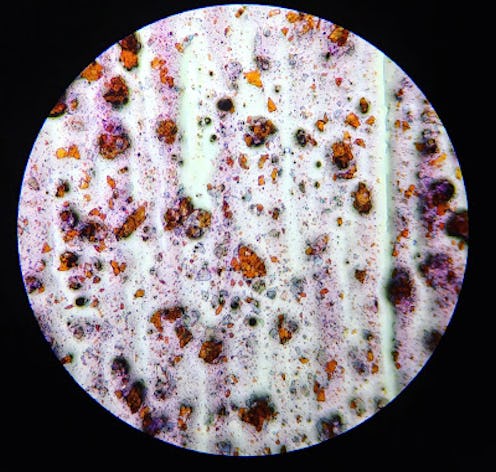
We know there are a lot of ingredients involved when it comes to getting one lipstick to sparkle and to turn another one matte, but nothing shows us that's true faster than putting lipstick underneath a microscope. Once you see the slides, it really hits home all the cool science involved in making your favorite lipstick shades.
If you've ever wondered why a certain brand feels silkier or is more longer lasting than another, then blogger Amy Oyler from The Scientific Mom is ready to educate you. In an experiment born out of curiosity, Oyler swatched some of her lipstick from brands like Benefit, Tarte, and Maybelline to see how they would look underneath her new microscope. But she can't take all the credit for the idea.
"I share a lot of my scientific explorations with my 11-year-old daughter, Katie, and it was actually her idea to do this!" Oyler shares in an interview with Bustle. "I had just purchased a new microscope to replace my older lab scope, and she suggested we test it out by looking at some of my makeup under the lens. It turned out to be a brilliant suggestion, as we were both blown away by the beautiful array of colors, the bright crystal shapes, and the structure of the makeup we were seeing through the lens!"
After getting a glimpse at the wild differences, Oyler's interest was piqued. She had to find out why the different samples looked the way they did when magnified. Why did some colors have large crystal formations, while others had very small particles of pigment? Why were there large bands separating some of the lipsticks, while others appeared smooth across the slide?
"As with many of the explorations in science that my daughter and I embark on, this became quite the adventure in learning and discovery! Soon, we were diving deep in the chemistry of makeup, the bonding of atoms through electron, the physics of light, and how this all interacts with the makeup and colors we love to wear. It truly became a blend of art, science, and the thrill of discovery while learning about the makeup we love to use," Oyler shares.
And her findings were fascinating. Just take a look:
According to Oyler, the above image is Benefit's "Dandelion" lip gloss, which is a pearly, pink gloss. Interesting enough, those broken crystals (called bismuth) are what gives it its sheen.
Oyler explains that it occurs naturally in nature, but when it's cultivated in a lab in a pure form, something interesting happens. "It grows into these beautiful towers of iridescent cubes that shimmer with blue, black, purple, teal, pink, and green! This mineral, when used in lipsticks or lip glosses, gives it a pearly look, that can change color depending on where the light hits it," she explains.
When you look at other samples, you'll notice that there are a bunch of tiny, colorful pigments inside of solid colors like "pink" or "purple." The reason for that is just as much color theory as it is chemistry.
"The process behind cosmetics creation is truly a masterful blend of art and science. Just as an artist would blend a variety of colors on a painter's palette to create vibrant reds, pinks, blues, etc for their masterpiece, so too, does a chemist blend a variety of pigments to come up with the perfect shade! In the case of corals, reds, purples, and pinks, there are a surprising number of blues and greens to give a subtle undertone to the overall color," Oyler explains.
Adding in different pigments gives you the difference between, say, a coral pink and a neon pink.
Curious how a super silky lippie looks compared to a matte one? It'll be heavy with oils, so it'll be rich and thick on the slide, with tight bands.
"Many of the colors I looked at had bands of color, separated in the same way that oil and water would be separated. Indeed, oil, wax, and water, make up the primary ingredients of lipstick!" Oyler shares. So the lipsticks that have the smoothest texture on our lips also had a similar texture under the lens. "They had a full, solid coating of fine pigments, evenly distributed, without as many bands spacing between them. Everything was held in place with waxes and oils, to provide a full coating of smooth and consistent color. The same look on the slide transferred into the same feel on the lips!"
In contrast, here's what a matte lipstick looks like — notice how far apart the bands are:
And the fun doesn't stop with lipsticks — Oyler fully expects to expand her exploration into eyeshadows, highlighters and more. But the really great thing is the way this idea has brought science to both girls and women everywhere.
"I've heard from teachers who are sharing it with their teenage students to inspire scientific explorations, scientists are taking this into their lab to check out their own favorite shades under the professional microscopes, and parents have been bringing their children with them to look at their own makeup under the microscope! It's been a wonderful way to share the beauty of science, and show that science can be found in just about every corner, even in your lipstick drawer," Oyler shares.
It will definitely make you look a little differently at what's inside your makeup bag, that's for sure.
Images: The Scientific Mom (1)